Review of Sensor Technology to Support Automated Air-to-Air Refueling of a Probe Configured Uncrewed Aircraft
Abstract
:1. Introduction
2. Background
2.1. Air-to-Air Refueling—Brief History
2.2. Conceptual Framework for Air-to-Air Refueling
- 1.
- A heading-based procedure that utilizes air-to-air equipment on both tanker and receiver.
- 2.
- A heading-based procedure that allows an airborne intercept radar to control the procedure upon radar contact.
- 3.
- A procedure in which the receiving aircraft maintains a specified track and the tanker maintains a reciprocal track at a predetermined offset.
2.3. Innovations for Automated Air-to-Air Refueling (A3R)
2.4. Crewed vs. Uncrewed Probe-and-Drogue Refueling
- Phase 1. Transitioning from Execution Portion to A3R Portion of Mission.
- Establish communications. Prior to initiation of refueling, communications and datalinks must be established between the UA and the tanker, and any supporting entities that are involved, such as the Ground Control Station (GCS) and Aerial Vehicle Operator (AVO). The GCS receives all pertinent data related to the A3R and the AVO monitors the performance of the UA (the AVO is analogous to a remote safety pilot). As technology advances, the role of the AVO will likely diminish as additional assurance in the system becomes available.
- Determine relative position. Determine the initial position of the UA relative to the tanker.
- Phase 2. UA Receiver Joins on Tanker.
- 3.
- Decrease separation to astern proximity. Once cleared by the tanker, decrease the separation of the two aircraft in a safe and predictable manner.
- Phase 3. UA Transitions from Astern to Engagement.
- 4.
- Transition to computer vision (CV). Once cleared by the tanker, arrive at the astern position to transition from position keeping provided by a data link or navigation aid to position keeping provided by a CV system. Object identification is required to provide location information to the guidance, navigation, and control (GNC) system; this information will then be translated by the UA to decrease the distance between the probe tip and the coupler, once cleared to contact by the tanker.
- 5.
- Position keeping during refueling. Transition back to relative position keeping upon successful engagement to allow fuel to transfer within the FTZ.
- Phase 4. UA Receiver Separates from Tanker.
- 6.
- Initiate separation after refueling. Once refueling is complete and cleared by the tanker, the receiver aircraft decreases airspeed to begin to increase the distance between the receiver and tanker. Upon reaching the limits of the hose reel, the probe tip will disconnect from the coupler and the receiver returns to astern position prior to transitioning to right echelon, when cleared by the tanker, for final administrative procedures.
- Phase 5. UA Receiver Proceeds on Mission.
- 7.
- Final separation to enable independent flight. Once cleared by the tanker, safely maneuver to increase separation between the two aircraft such that the UA can transition away from relative position keeping to continue the next mission task.
3. Review of Sensor Requirements for A3R
3.1. Method for Sensor Selection and Limitations
3.2. Ensure Communications
3.3. Determine Relative Position
3.4. Decrease Separation to Astern Proximity
3.5. Transition to Computer Vision
3.6. Object Identification to Support Probe Placement
3.7. Position Keeping during Refueling
3.8. Initiate Separation after Refueling
3.9. Final Separation to Enable Independent Flight
3.10. ODD Considerations
3.11. Safety Considerations
4. Discussion and Conclusions
4.1. Challenges to Fielding a UA Capable of A3R
4.2. Conclusions
Author Contributions
Funding
Institutional Review Board Statement
Informed Consent Statement
Data Availability Statement
Acknowledgments
Conflicts of Interest
References
- Smith, R.K. Seventy-Five Years of Inflight Refueling: Highlights, 1923–1998. In Seventy Five Years of Inflight Refueling; Air Force History and Museums Program: Washington, DC, USA, 1998. [Google Scholar]
- Federal Aviation Administration (FAA)/Aviation Supplies & Academics (ASA). FAR/AIM 2022: Federal Aviation Regulations/Aeronautical Information Manual; FAR/AIM 2022; Aviation Supplies & Academics, Inc.: Newcastle, WA, USA, 2021. [Google Scholar]
- Nangia, R.K. ‘Greener’ civil aviation using air-to-air refuelling—Relating aircraft design efficiency and tanker offload efficiency. Aeronaut. J. 2007, 111, 589–592. [Google Scholar] [CrossRef]
- Winnefeld, J.A.; Niblack, P.; Johnson, D.J. A League of Airmen: U.S. Air Power in the Gulf War; Rand: Santa Monica, CA, USA, 1994. [Google Scholar]
- Vergun, D. Aerial Refueling Adds Lethality to DOD Aviation. 2020. Available online: https://www.defense.gov/News/Feature-Stories/Story/Article/2089889/aerial-refueling-adds-lethality-to-dod-aviation/ (accessed on 30 December 2022).
- Joint Air Power Competence Centre. United States ATP 3.3.4.2.(D). In US Standards Related Document (SRD); Joint Air Power Competence Centre: Kalkar, Germany, 2022. [Google Scholar]
- Simsek, D.; Akturk, M.S. Resilient airline scheduling to minimize delay risks. Transp. Res. Part C Emerg. Technol. 2022, 141, 103734. [Google Scholar] [CrossRef]
- Federal Aviation Adminstration. Part 107 Airspace Authorizations. 2022. Available online: https://www.faa.gov/uas/commercial_operators/part_107_airspace_authorizations (accessed on 10 December 2022).
- Chief of Naval Operations. Navy Aviation Vision 2030–2035; United States Naval, Ed.; Naval Aviation Enterprise: San Diego, CA, USA, 2021. [Google Scholar]
- Guin, M.K.; Hiremath, S.; Shrishail, M.H. Semi-Autonomous UAV based Weather and Air Pollution Monitoring System. J. Phys. Conf. Ser. 2021, 1921, 12091. [Google Scholar] [CrossRef]
- Ghali, R.; Akhloufi, M.A.; Mseddi, W.S. Deep Learning and Transformer Approaches for UAV-Based Wildfire Detection and Segmentation. Sensors 2022, 22, 1977. [Google Scholar] [CrossRef]
- Hong, L.; Wang, Y.; Du, Y.; Chen, X.; Zheng, Y. UAV search-and-rescue planning using an adaptive memetic algorithm. Front. Inf. Technol. Electron. Eng. 2021, 22, 1477–1491. [Google Scholar] [CrossRef]
- Oh, D.; Han, J. Smart Search System of Autonomous Flight UAVs for Disaster Rescue. Sensors 2021, 21, 6810. [Google Scholar] [CrossRef]
- Chen, Q.; Zhao, Q.; Zou, Z. Threat-Oriented Collaborative Path Planning of Unmanned Reconnaissance Mission for the Target Group. Aerospace 2022, 9, 577. [Google Scholar] [CrossRef]
- The Wright Brothers Were “First in Flight” on 17 December 1903; Read to Know; Knowledge Unlimited: Middleton, WI, USA, 2021; Volume 71.
- Air Force Aerial Refueling Methods: Flying Boom Versus Hose-and-Drogue (RL32910); Air Force Aerial Refueling Methods; UNT Digital Library: Dallas, TX, USA, 2006.
- Joint Air Power Competence Centre. ATP 3.3.4.2 Ed D Air-To-Air Refuelling; NATO Standardization Office (NSO): Brussels, Belgium, 2019. [Google Scholar]
- Nickell, C. Aerial Refueling Receiver Certification Test Methodology; US Navy White Paper: Washington, DC, USA, 2021; pp. 1–16. [Google Scholar]
- Xu, Y.; Duan, H.; Li, C.; Deng, Y. On-board visual navigation system for unmanned aerial vehicles autonomous aerial refueling. Proc. Inst. Mech. Engineers. Part G J. Aerosp. Eng. 2019, 233, 1193–1203. [Google Scholar] [CrossRef]
- Shi, B.; Liu, Z.; Zhang, G. Vision Sensor for Measuring Aerial Refueling Drogue Using Robust Method. IEEE Sens. J. 2021, 21, 28037–28049. [Google Scholar] [CrossRef]
- Luo, D.; Shao, J.; Xu, Y.; Zhang, J. Docking navigation method for UAV autonomous aerial refueling. Sci. China Inf. Sci. 2019, 62, 010203:1–010203:16. [Google Scholar] [CrossRef]
- Huang, B.; Sun, Y.; Zeng, Q. Real-time drogue detection and template tracking strategy for autonomous aerial refueling. J. Real-Time Image Process. 2020, 17, 437–446. [Google Scholar] [CrossRef]
- Wu, L.; Sun, Y.; Zhao, K.; Fu, X. A Novel Vision-Based PRPL Multistage Image Processing Algorithm for Autonomous Aerial Refueling. Wirel. Commun. Mob. Comput. 2021, 2021, 2778857. [Google Scholar] [CrossRef]
- Haibin, D.; Qifu, Z. Visual Measurement in Simulation Environment for Vision-Based UAV Autonomous Aerial Refueling. IEEE Trans. Instrum. Meas. 2015, 64, 2468–2480. [Google Scholar] [CrossRef]
- Duan, H.; Li, H.; Luo, Q.; Zhang, C.; Li, C.; Li, P.; Deng, Y. A binocular vision-based UAVs autonomous aerial refueling platform. Sci. China Inf. Sci. 2016, 59, 228–234. [Google Scholar] [CrossRef] [Green Version]
- Thomas, P.R.; Bhandari, U.; Bullock, S.; Richardson, T.S.; du Bois, J.L. Advances in air to air refuelling. Prog. Aerosp. Sci. 2014, 71, 14–35. [Google Scholar] [CrossRef]
- Hu, Z.; Suozhong, Y.; Qian, S. Vision/GPS-based docking control for the UAV Autonomous Aerial Refueling. In Proceedings of the 2016 IEEE Chinese Guidance, Navigation and Control Conference (CGNCC), Nanjing, China, 12–14 August 2016. [Google Scholar]
- Dong, X.M.; Jia, H.Y.; Guo, J.; Wang, L. Autonomous Aerial Refueling for UAVs Based on GPS/MV; Trans Tech Publications Ltd.: Bäch, Switzerland, 2012. [Google Scholar]
- Williamson, W.R.; Glenn, G.J.; Dang, V.T.; Speyer, J.L.; Stecko, S.M.; Takacs, J.M. Sensor Fusion Applied to Autonomous Aerial Refueling. J. Guid. Control. Dyn. 2009, 32, 262–275. [Google Scholar] [CrossRef]
- Wang, X.; Dong, X.; Kong, X.; Li, J.; Zhang, B. Drogue detection for autonomous aerial refueling based on convolutional neural networks. Chin. J. Aeronaut. 2017, 30, 380–390. [Google Scholar] [CrossRef]
- Wang, Z.; Qu, Y.; Wu, J.; Xiao, B.; Yan, J. Tracking Algorithm with Adaptive Bandwidth of Kernel Function for UAV Autonomous Aerial Refueling. MATEC Web Conf. 2017, 139, 57. [Google Scholar] [CrossRef] [Green Version]
- Martínez, C.; Richardson, T.; Thomas, P.; du Bois, J.L.; Campoy, P. A vision-based strategy for autonomous aerial refueling tasks. Robot. Auton. Syst. 2013, 61, 876–895. [Google Scholar] [CrossRef]
- Ma, Y.; Zhao, R.; Liu, E.; Zhang, Z.; Yan, K. A novel autonomous aerial refueling drogue detection and pose estimation method based on monocular vision. Meas. J. Int. Meas. Confed. 2019, 136, 132–142. [Google Scholar] [CrossRef]
- Parsons, C.; Paulson, Z.; Nykl, S.; Dallman, W.; Woolley, B.G.; Pecarina, J. Analysis of Simulated Imagery for Real-Time Vision-Based Automated Aerial Refueling. J. Aerosp. Inf. Syst. 2019, 16, 77–93. [Google Scholar] [CrossRef]
- Lee, A.; Dallmann, W.; Nykl, S.; Taylor, C.; Borghetti, B. Long-Range Pose Estimation for Aerial Refueling Approaches Using Deep Neural Networks. J. Aerosp. Inf. Syst. 2020, 17, 634–646. [Google Scholar] [CrossRef]
- Johnson, D.T.; Nykl, S.L.; Raquet, J.F. Combining Stereo Vision and Inertial Navigation for Automated Aerial Refueling. J. Guid. Control. Dyn. 2017, 40, 2250–2259. [Google Scholar] [CrossRef] [Green Version]
- Hansen, J.L.; Murray, J.E.; Campos, N.V. The NASA Dryden AAR Project: A Flight Test Approach to an Aerial Refueling System. In Proceedings of the AIAA Atmospheric Flight Mechanics Conference and Exhibit, Keystone, CO, USA, 21–24 August 2006. [Google Scholar]
- LaGrone, S. Navy Conducts Successful Test of Aerial Refueling with X-47B, UCAS-D Program Ending. United States Naval Institute 2015 April 22. Available online: https://news.usni.org/2015/04/22/navy-conducts-successful-test-of-aerial-refueling-on-x-47b-ucas-d-program-ending (accessed on 15 November 2022).
- Quigley, A. Navy Completes First Unmanned Aerial Refueling Using MQ-25 Stingray Prototype; InsideDefense.com’s Unmanned Systems Alert; Breaking Media, Inc.: New York, NY, USA, 2021. [Google Scholar]
- Decker, A. Navy Completes Unmanned Aerial Refueling Test with MQ-25 and E-2D; InsideDefense.com’s Unmanned Systems Alert; Breaking Media, Inc.: New York, NY, USA, 2021. [Google Scholar]
- Public Affairs Officer. Air Test and Evaluation Squadron (VX) 23 Fact Sheet. NAWCAD 2022. Available online: https://www.navair.navy.mil/nawcad/vx23 (accessed on 10 December 2022).
- Public Affairs Officer. Air Test and Evaluation Squadron (VX) 20 Fact Sheet. NAWCAD 2022. Available online: https://www.navair.navy.mil/nawcad/vx20 (accessed on 10 December 2022).
- Johannes, B.; Rothe, S.; Gens, A.; Westphal, S.; Birkenfeld, K.; Mulder, E.; Rittweger, J.; Ledderhos, C. Psychophysiological Assessment in Pilots Performing Challenging Simulated and Real Flight Maneuvers. Aerosp. Med. Hum. Perform. 2017, 88, 834–840. [Google Scholar] [CrossRef] [PubMed] [Green Version]
- Joint Air Power Competence Center. ATP-3.3.4.10 Automated Air-to-Air Refueling (A3R); Allied Tactical Publication, Ed.; NATO Standardization Office (NSO): Brussels, Belgium, 2021. [Google Scholar]
- Chang, C.-W.; Lo, L.-Y.; Cheung, H.C.; Feng, Y.; Yang, A.-S.; Wen, C.-Y.; Zhou, W. Proactive Guidance for Accurate UAV Landing on a Dynamic Platform: A Visual-Inertial Approach. Sensors 2022, 22, 404. [Google Scholar] [CrossRef]
- Thorn, E.; Kimmel, S.; Chaka, M. A Framework for Automated Driving System Testable Cases and Scenarios; National Highway Traffic Safety Administration, Ed.; U.S. Department of Transportation: Washington, DC, USA, 2018.
- United States Army UAS Center of Excellence. “Eyes of the Army” U.S. Army Roadmap for Unmanned Aircraft Systems; United States Army, Ed.; United States Army UAS Center of Excellence: Indian Springs, NV, USA, 2009. [Google Scholar]
- Kanovsky, P.; Korenčiak, L.U.; Adamová, E.J. Cost-Optimized Avionics System—Surveillance Solution with Radar for Small Aircraft Transportation Segment. IOP Conf. Ser. Mater. Sci. Eng. 2022, 1226, 12088. [Google Scholar] [CrossRef]
- Schwarz, R. Worldwide Spectrum Allocations; International Telecommunication Union: Geneva, Switzerland, 2020. [Google Scholar]
- Lockheed Martin. F-35 Capabilities. 2022. Available online: https://www.lockheedmartin.com/en-us/products/f-35/f-35-capabilities.html (accessed on 10 December 2022).
- Vasile, P.; Cioacă, C.; Luculescu, D.; Luchian, A.; Pop, S. Consideration about UAV command and control. Ground Control Station. J. Phys. Conf. Ser. 2019, 1297, 12007. [Google Scholar] [CrossRef] [Green Version]
- Nagarajan, P.; Kannan, S.K.; Vukas, M.E.; Torens, C.; Wilber, G.F. ASTM F3269-an Industry Standard on Run Time Assurance for Aircraft Systems; AIAA Scitech 2021 Forum; ASTM: West Conshohocken, PA, USA, 2021; p. 0525. [Google Scholar]
- Livermore, R.A.; Leonard, A.W. Test and Evaluation of Autonomy for Air Platforms; 412th Test Wing; Air Force Material Command: Edwards, CA, USA, 2020. [Google Scholar]
- AbdElHamid, A.; Zong, P.; Abdelhamid, B. Advanced Software Ground Station and UAV Development for NLoS Control Using Mobile Communications. Discret. Dyn. Nat. Soc. 2015, 2015, 285746. [Google Scholar] [CrossRef] [Green Version]
- Krichen, L.; Fourati, M.; Fourtai, L.C. Communication architecture for unmanned aerial vehicle system. In Proceedings of the International Conference on Ad-Hoc Networks and Wireless, Saint Malo, France, 5–7 September 2018; pp. 213–225. [Google Scholar]
- Okcu, H. Operational Requirements of Unmanned Aircraft Systems Data Link and Communication Systems. J. Adv. Comput. Netw. 2016, 4, 28–32. [Google Scholar] [CrossRef] [Green Version]
- Suryana, J.; Candra, D. Implementation of Link-16 based Tactical Data Link System Using Software-Defined Radio. In Proceedings of the 2019 International Conference on Electrical Engineering and Informatics (ICEEI), Bandung, Indonesia, 9–10 July 2019; IEEE: Piscataway, NJ, USA. [Google Scholar]
- Bull, J.F.; Zebrowitz, H.Z.; Arnao, M.A. A versatile adaptive array for LINK-11 communications. In Proceedings of the IEEE MILCOM 91-Conference Record, McLean, VA, USA, 4–7 November 1991. [Google Scholar]
- Collins, R. New Data Link May Enable F-35 to Talk to Other Aircraft. ECN. 2015. Available online: https://www.designworldonline.com/new-data-link-may-enable-f-35-to-talk-to-other-aircraft/ (accessed on 10 December 2022).
- Williamson, W.R.; Abdel-Hafez, M.F.; Rhee, I.; Song, E.J.; Wolfe, J.; Cooper, D.; Chichka, D.F.; Speyer, J.L. A Formation Flight Experiment Using Differential Carrier Phase for Precise Relative Navigation. In Proceedings of the 15th International Technical Meeting of the Satellite Division of The Institute of Navigation (ION GPS 2002), Portland, OR, USA, 24–27 September 2002. [Google Scholar]
- Raja, M.; Asthana, G.; Singh, A.; Singhal, A.; Lakra, P. Design of Accurate Navigation System by Integrating INS and GPS modules. INCAS Bull. 2019, 11, 139–154. [Google Scholar] [CrossRef]
- Li, X.; Ge, M.; Dai, X.; Ren, X.; Fritsche, M.; Wickert, J.; Schuh, H. Accuracy and reliability of multi-GNSS real-time precise positioning: GPS, GLONASS, BeiDou, and Galileo. J. Geod. 2015, 89, 607–635. [Google Scholar] [CrossRef] [Green Version]
- Van den Bergh, B.; Pollin, S. Keeping UAVs Under Control During GPS Jamming. IEEE Syst. J. 2019, 13, 2010–2021. [Google Scholar] [CrossRef]
- Morales, J.J.; Kassas, Z.M. Tightly Coupled Inertial Navigation System with Signals of Opportunity Aiding. IEEE Trans. Aerosp. Electron. Syst. 2021, 57, 1930–1948. [Google Scholar] [CrossRef]
- Morales, J.J.; Kassas, Z.M. Stochastic Observability and Uncertainty Characterization in Simultaneous Receiver and Transmitter Localization. IEEE Trans. Aerosp. Electron. Syst. 2019, 55, 1021–1031. [Google Scholar] [CrossRef]
- İşci, H.; Günel, G.Ö. Fuzzy logic based air-to-air combat algorithm for unmanned air vehicles. Int. J. Dyn. Control. 2022, 10, 230–242. [Google Scholar] [CrossRef]
- Luciana, V.J. Accuracy Test of an Air-to-Air Ranging and Bearing System; Federal Aviation Adminstration, Ed.; National Technical Information Service: Springfield, IL, USA, 1977. [Google Scholar]
- Shankar, R. Fusion of Onboard Sensors for Better Navigation. Def. Sci. J. 2013, 63, 145–152. [Google Scholar] [CrossRef] [Green Version]
- Nitti, D.O.; Bovenga, F.; Chiaradia, M.T.; Greco, M.; Pinelli, G. Feasibility of Using Synthetic Aperture Radar to Aid UAV Navigation. Sensors 2015, 15, 18334–18359. [Google Scholar] [CrossRef] [Green Version]
- Moses, A.; Rutherford, M.J.; Kontitsis, M.; Valavanis, K.P. UAV-borne X-band radar for collision avoidance. Robotica 2014, 32, 97–114. [Google Scholar] [CrossRef]
- Delahoussaye, P.J. Modification of the F-14: A Case Study in Decisions Affecting a Major Systems Upgrade; Naval Postgradute School: Monterey, CA, USA, 1994. [Google Scholar]
- Qu, H.-m.; Cao, D.; Zheng, Q.; Li, Y.-y.; Chen, Q. Accuracy test and analysis for infrared search and track system. Optik 2013, 124, 2313–2317. [Google Scholar] [CrossRef]
- Zhu, Y.; Sun, Y.; Zhao, W.; Huang, B.; Wu, L. Relative navigation for autonomous aerial refueling rendezvous phase. Optik 2018, 174, 665–675. [Google Scholar] [CrossRef]
- Yasin, J.N.; Mohamed, S.A.S.; Haghbayan, M.-H.; Heikkonen, J.; Tenhunen, H.; Plosila, J. Unmanned Aerial Vehicles (UAVs): Collision Avoidance Systems and Approaches. IEEE Access 2020, 8, 105139–105155. [Google Scholar] [CrossRef]
- Ouahouah, S.; Bagaa, M.; Prados-Garzon, J.; Taleb, T. Deep-Reinforcement-Learning-Based Collision Avoidance in UAV Environment. IEEE Internet Things J. 2022, 9, 4015–4030. [Google Scholar] [CrossRef]
- Zhang, M. Formation flight and collision avoidance for multiple UAVs based on modified tentacle algorithm in unstructured environments. PLoS ONE 2017, 12, e0182006. [Google Scholar] [CrossRef] [PubMed] [Green Version]
- Liu, D.; Chen, X. An ANN-Based Data Fusion Algorithm for INS/CNS Integrated Navigation System. IEEE Sens. J. 2022, 22, 7846–7854. [Google Scholar] [CrossRef]
- García, J.; Molina, J.M.; Trincado, J. Real evaluation for designing sensor fusion in UAV platforms. Inf. Fusion 2020, 63, 136–152. [Google Scholar] [CrossRef]
- Peng, J.; Zhang, P.; Zheng, L.; Tan, J. UAV Positioning Based on Multi-Sensor Fusion. IEEE Access 2020, 8, 34455–34467. [Google Scholar] [CrossRef]
- Costello, D.H.; Xu, H. Relating Sensor Degradation to Vehicle Situational Awareness for Autonomous Air Vehicle Certification. J. Aerosp. Inf. Syst. 2021, 18, 193–202. [Google Scholar] [CrossRef]
- Instrument Procedures Handbook; First Skyhorse Publishing Edition; Skyhorse Publishing: New York, NY, USA, 2015.
- Krasuski, K.; Popielarczyk, D.; Ciećko, A.; Ćwiklak, J. A New Strategy for Improving the Accuracy of Aircraft Positioning Using DGPS Technique in Aerial Navigation. Energies 2021, 14, 4431. [Google Scholar] [CrossRef]
- Krasuski, K.; Ćwiklak, J.; Grzesik, N. Accuracy Assessment of Aircraft Positioning by Using the DGLONASS Method in the GBAS System. J. KONBiN 2018, 45, 97–124. [Google Scholar] [CrossRef] [Green Version]
- Gross, J.N.; Yu, G.; Rhudy, M.B. Robust UAV Relative Navigation With DGPS, INS, and Peer-to-Peer Radio Ranging. IEEE Trans. Autom. Sci. Eng. 2015, 12, 935–944. [Google Scholar] [CrossRef]
- D’Amico, S.; Montenbruck, O. Differential GPS: An Enabling Technology for Formation Flying Satellites; Springer: Berlin/Heidelberg, Germany, 2009; pp. 457–465. [Google Scholar]
- Pervan, B.; Chan, F.C.; Gebre-Egziabher, D.; Pullen, S.A.M.; Enge, P.E.R.; Colby, G. Performance Analysis of Carrier-Phase DGPS Navigation for Shipboard Landing of Aircraft. Navigation 2003, 50, 181–191. [Google Scholar] [CrossRef]
- Grzegorzewski, M.; Jaruszewski, W.; Fellner, A.; Oszczak, S.; Wasilewski, A.; Rzepecka, Z.; Kapcia, J.; Olsztyn; Popławski, T. Preliminary results of DGPS/DGLONASS aircraft positioning in flight approaches and landings. Annu. Navig. 1999, 41–53. [Google Scholar]
- Brown, A.K.; Nguyen, D.; Felker, P.; Colby, G.; Allen, F. Unmanned air systems: Precision navigation for critical operations. GPS World 2012, 23, 10. [Google Scholar]
- Chen, C.-I.; Koseluk, R.; Buchanan, C.; Duerner, A.; Jeppesen, B.; Laux, H. Autonomous Aerial Refueling Ground Test Demonstration—A Sensor-in-the-Loop, Non-Tracking Method. Sensors 2015, 15, 10948–10972. [Google Scholar] [CrossRef] [PubMed] [Green Version]
- Wang, X.; Kong, X.; Zhi, J.; Chen, Y.; Dong, X. Real-time drogue recognition and 3D locating for UAV autonomous aerial refueling based on monocular machine vision. Chin. J. Aeronaut. 2015, 28, 1667–1675. [Google Scholar] [CrossRef] [Green Version]
- Daedalean, E.A. Concepts of Design Assurance for Neural Networks (CoDANN) II; EASA: Cologne, Germany, 2021.
- Parry, J.; Costello, D.; Rupert, J.; Taylor, G. The National Airworthiness Council Artificial Intelligence Working Group (NACAIWG) Summit Proceedings 2022 [Conference presentation]; National Airworthiness Council Artificial Intelligence Working Group: Patuxent River, MD, USA, 2022. [Google Scholar]
- Fravolini, M.L.; Ficola, A.; Campa, G.; Napolitano, M.R.; Seanor, B. Modeling and control issues for autonomous aerial refueling for UAVs using a probe–drogue refueling system. Aerosp. Sci. Technol. 2004, 8, 611–618. [Google Scholar] [CrossRef]
- Fezans, N.; Jann, T. Towards automation of aerial refuelling manoeuvres with the probe-and-drogue system: Modelling and simulation. Transp. Res. Procedia 2018, 29, 116–134. [Google Scholar] [CrossRef]
- Mauldin, C.A.; Parry, J.K.; Costello, D.H. First Steps Toward Certifying an UAS to Receive Fuel Airborne. In Proceedings of the 2022 International Conference on Unmanned Aircraft Systems (ICUAS), Dubrovnik, Croatia, 21–24 June 2022. [Google Scholar]
- Chen, S.; Duan, H.; Deng, Y.; Li, C.; Zhao, G.; Xu, Y. Drogue pose estimation for unmanned aerial vehicle autonomous aerial refueling system based on infrared vision sensor. Opt. Eng. 2017, 56, 124105. [Google Scholar] [CrossRef]
- Thuloweit, K. Aerial Refueling Probe Light Evaluations Flown with KC-135: Effort to Clear Navy, USMC F-35 Night Refueling Envelope; Federal Information & News Dispatch, LLC: Washington, DC, USA, 2019. [Google Scholar]
- Kapoor, R.; Ramasamy, S.; Gardi, A.; Schyndel, R.V.; Sabatini, R. Acoustic Sensors for Air and Surface Navigation Applications. Sensors 2018, 18, 499. [Google Scholar] [CrossRef] [Green Version]
- Kang, J.-G.; Kim, T.; Kwon, L.; Kim, H.-D.; Park, J.-S. Design and Implementation of a UUV Tracking Algorithm for a USV. Drones 2022, 6, 66. [Google Scholar] [CrossRef]
- Wu, C.; Yan, J.; Shen, J.; Wu, X.; Xiao, B. Predefined-Time Attitude Stabilization of Receiver Aircraft in Aerial Refueling. IEEE Trans. Circuits Syst. II Express Briefs 2021, 68, 3321–3325. [Google Scholar] [CrossRef]
- Sevil, H.E.; Dogan, A. Fault Diagnosis in Air Data Sensors for Receiver Aircraft in Aerial Refueling. J. Guid. Control. Dyn. 2015, 38, 1959–1975. [Google Scholar] [CrossRef]
- Tumas, P.; Nowosielski, A.; Serackis, A. Pedestrian Detection in Severe Weather Conditions. IEEE Access 2020, 8, 62775–62784. [Google Scholar] [CrossRef]
- Gaitanakis, G.-K.; Limnaios, G.; Zikidis, K.C. On the use of AESA (Active Electronically Scanned Array) Radar and IRST (InfraRed Search&Track) System to Detect and Track Low Observable Threats. MATEC Web Conf. 2019, 304, 4001. [Google Scholar]
- Ellis, O.; Durak, U. Simulation Based Verification of Drogue Detection Algorithms for Autonomous Aerial Refueling; AIAA SciTech Forum; ASTM: West Conshohocken, PA, USA, 2020; pp. 1–10. [Google Scholar]
- Balestrieri, E.; Daponte, P.; De Vito, L.; Lamonaca, F. Sensors and Measurements for Unmanned Systems: An Overview. Sensors 2021, 21, 1518. [Google Scholar] [CrossRef] [PubMed]
- DAF/MIT AI Accelerator, Artificial Intelligence Acquisition Guidebook; Massachusetts Institute of Technology: Cambridge, MA, USA, 2022.
- Wojton, H.M.; Porter, D.J.; Dennis, J.W. Test & Evaluation of AI-enabled and Autonomous Systems: A Literature Review; Institute for Defense Analyses, Ed.; Institute for Defense Analyses: Alexandria, VA, USA, 2021. [Google Scholar]
- SAE International. Artificial Intelligence in Aeronautical Systems: Statement of Concerns; SAE International: Warrendale, PA, USA, 2021. [Google Scholar]



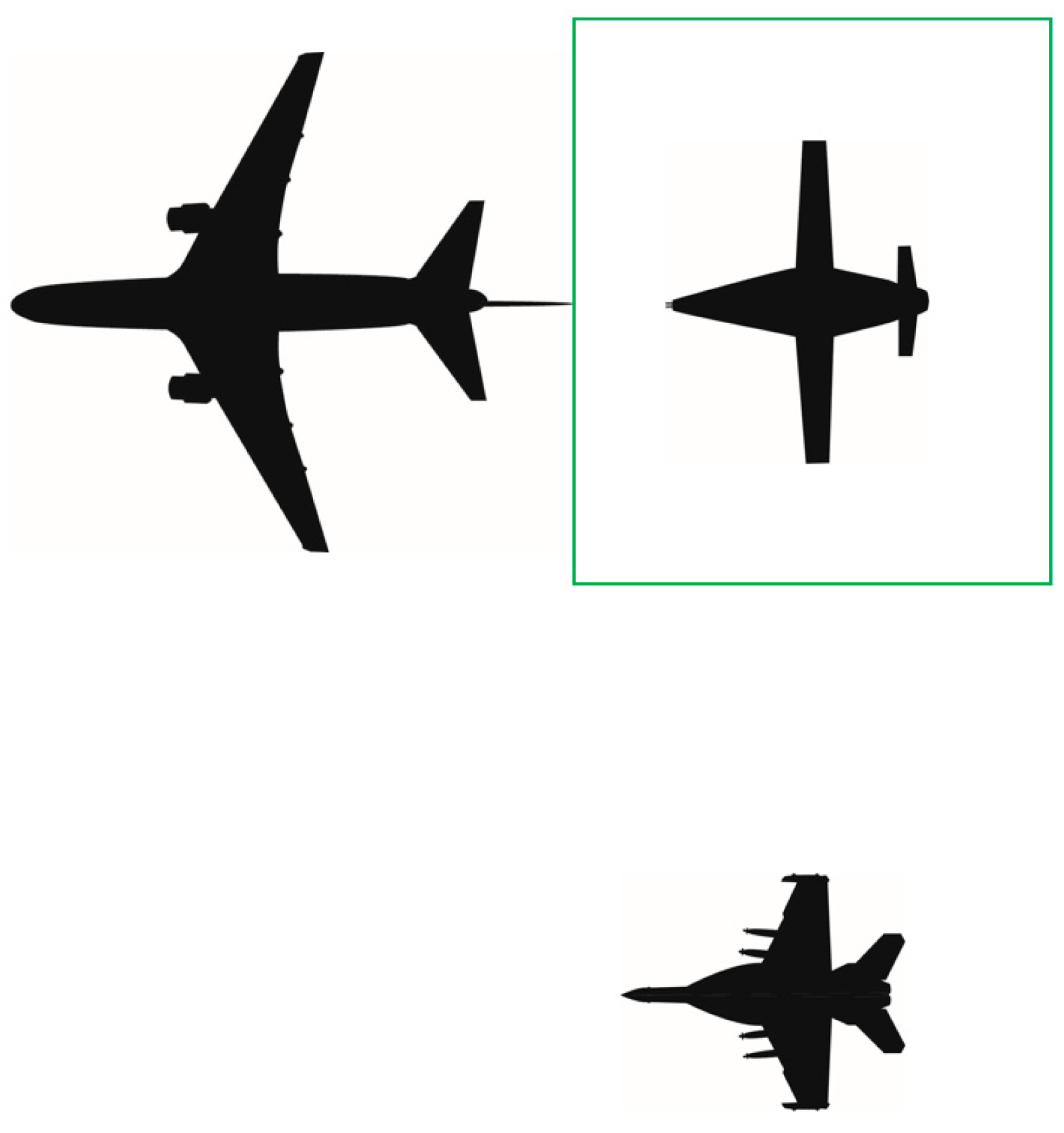

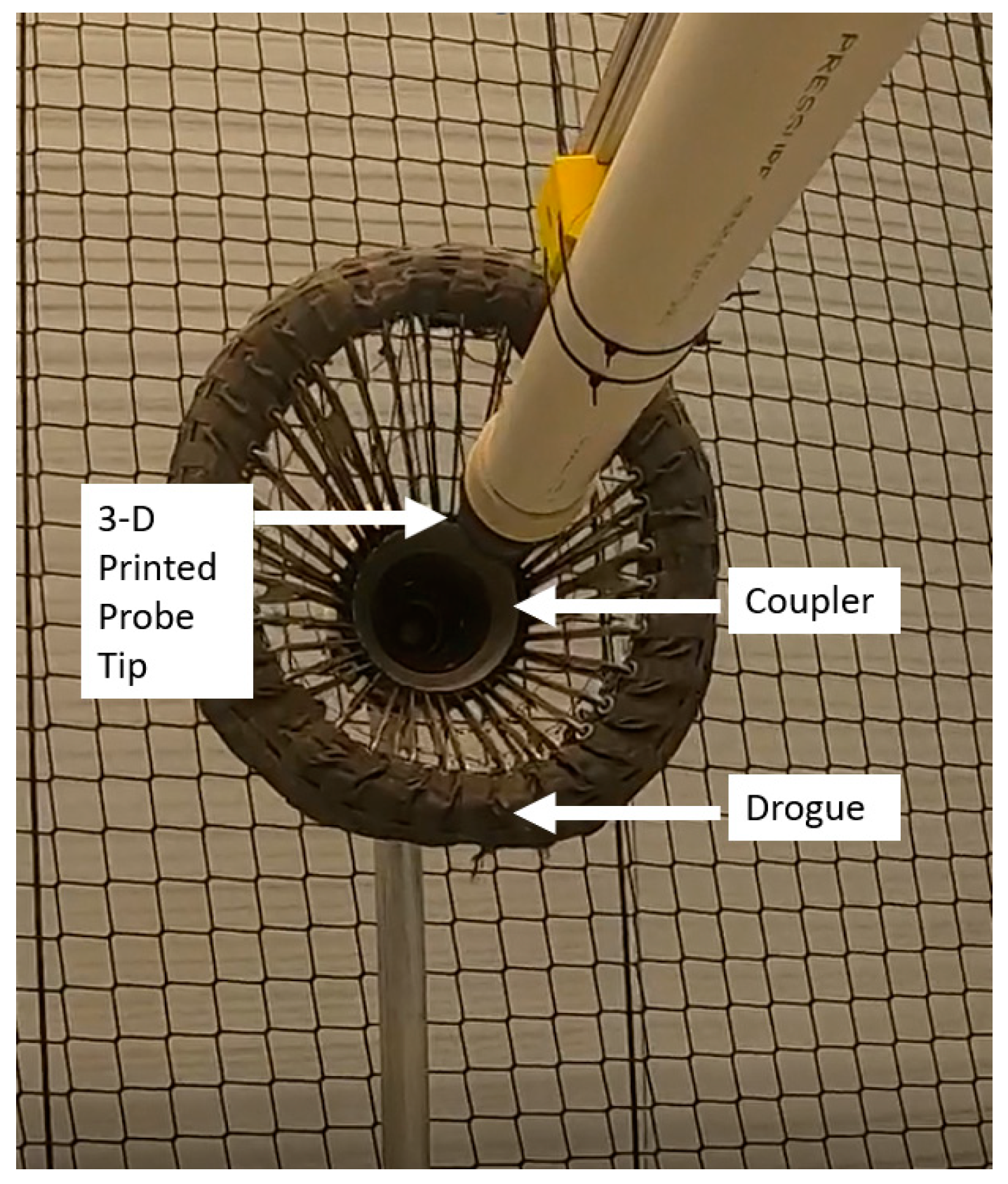
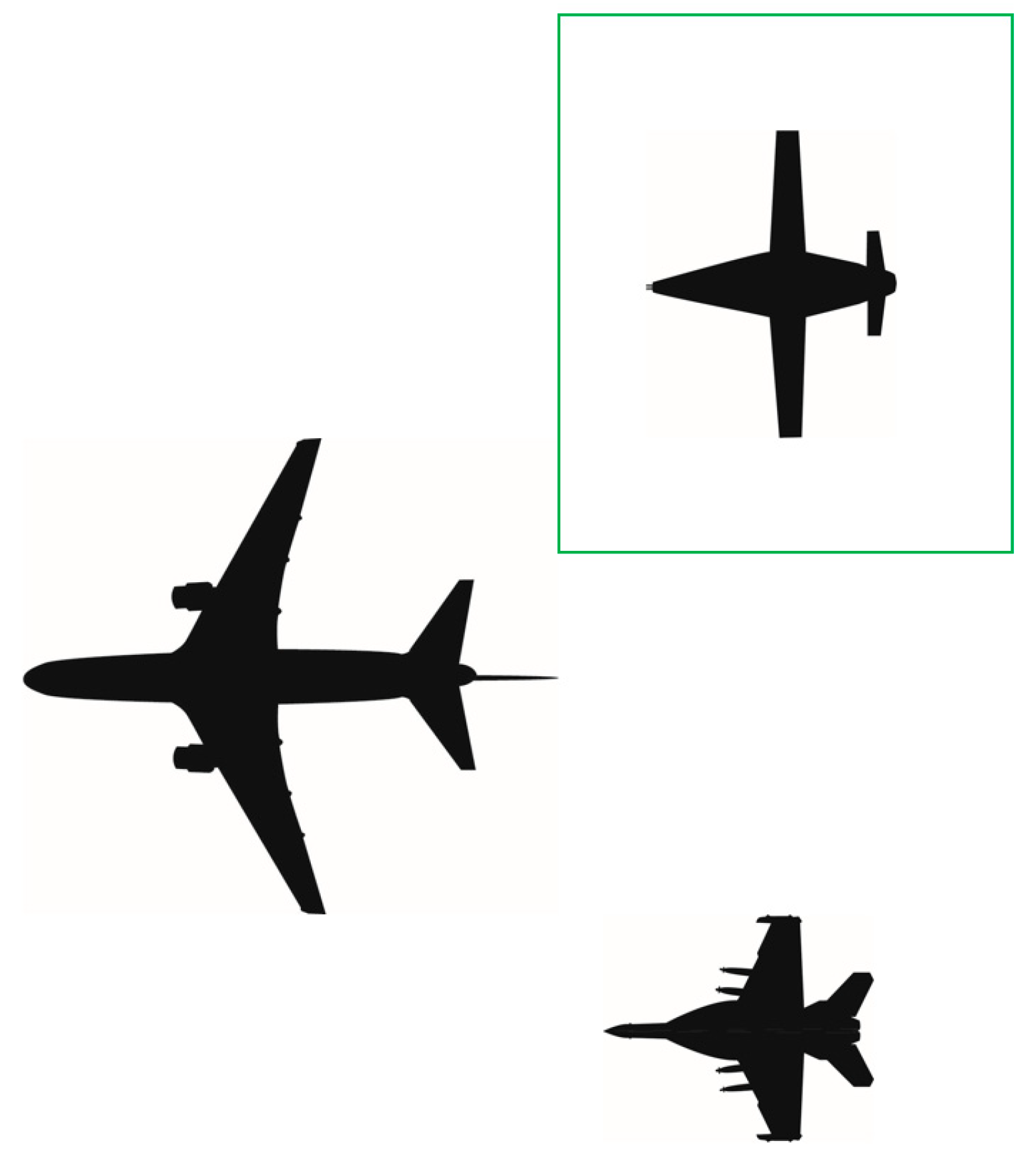
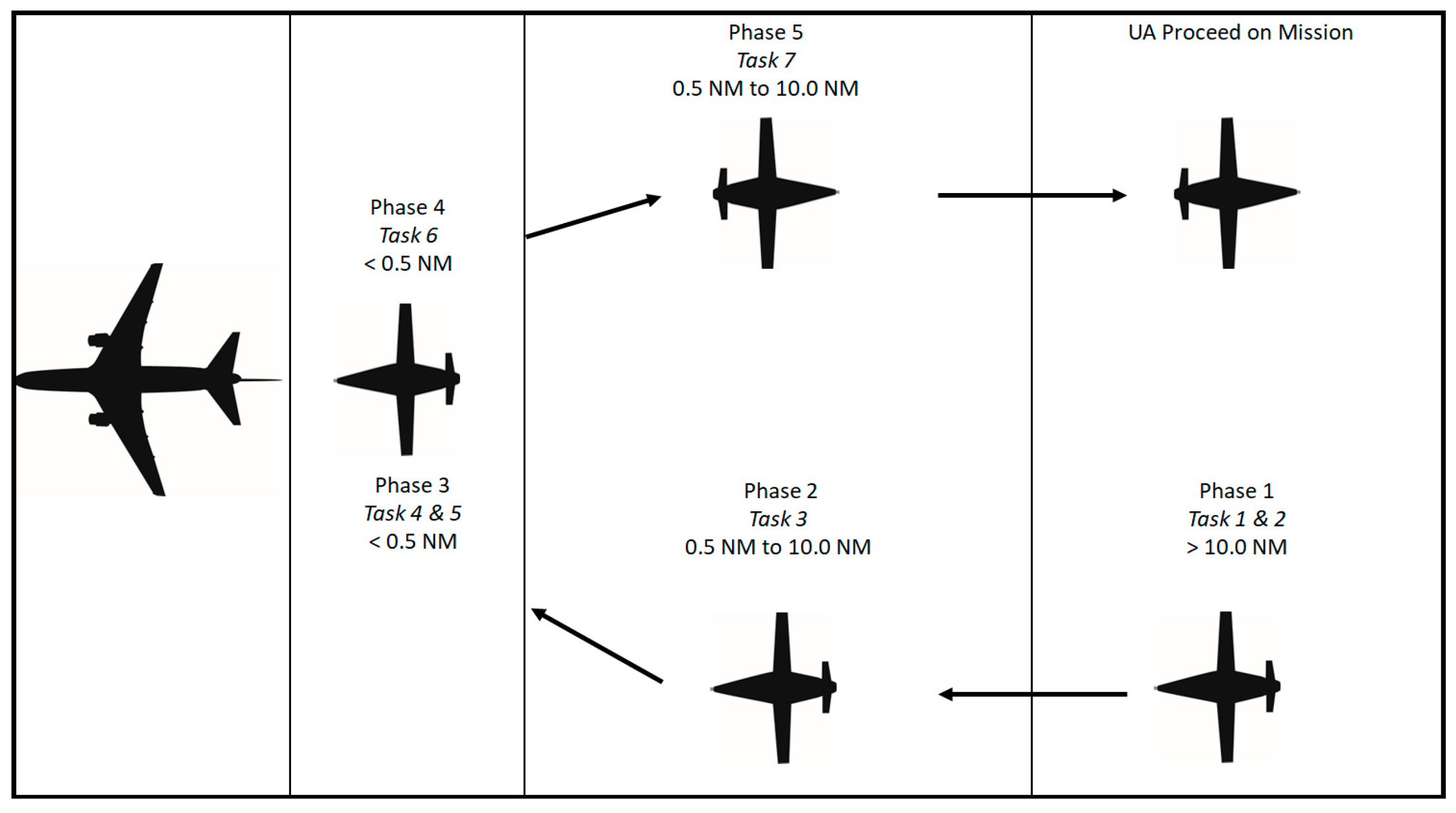



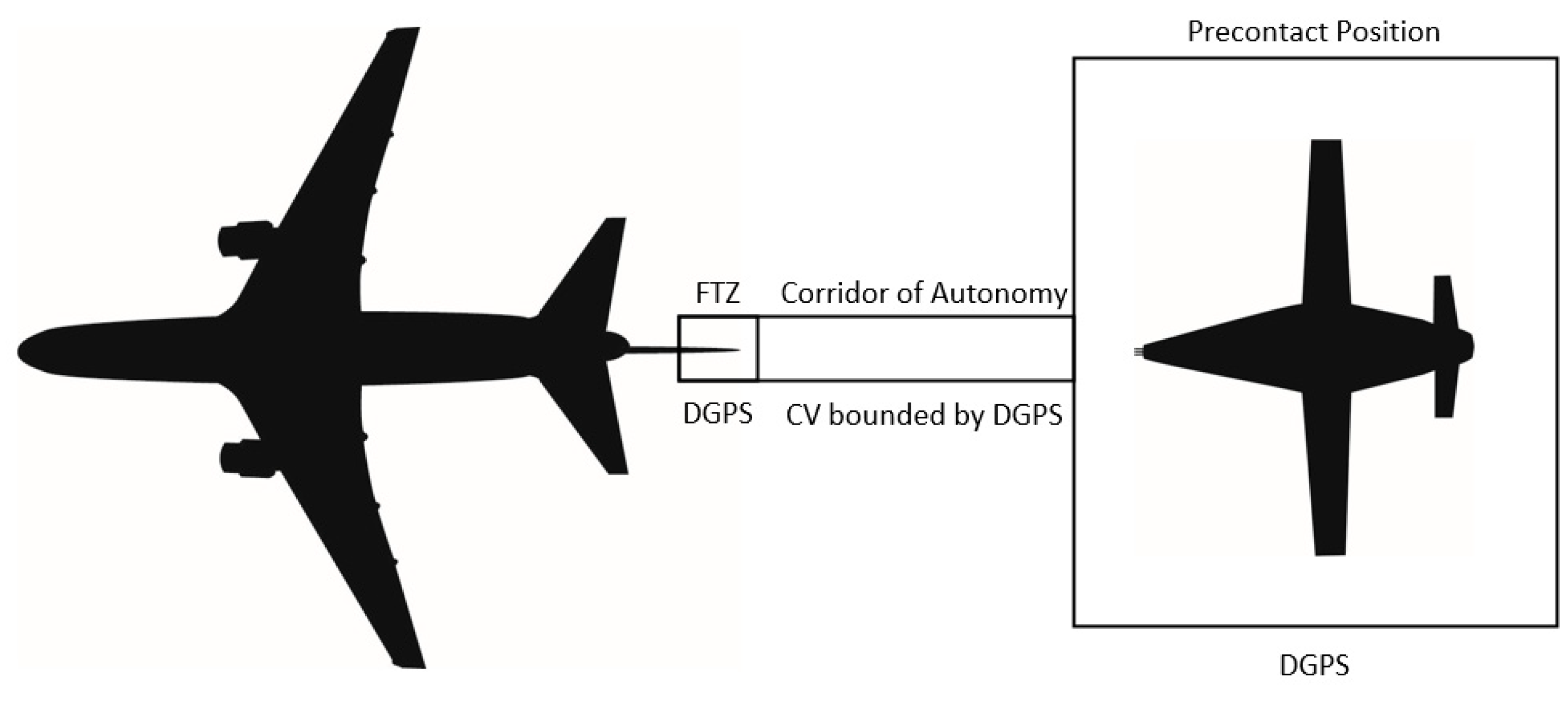
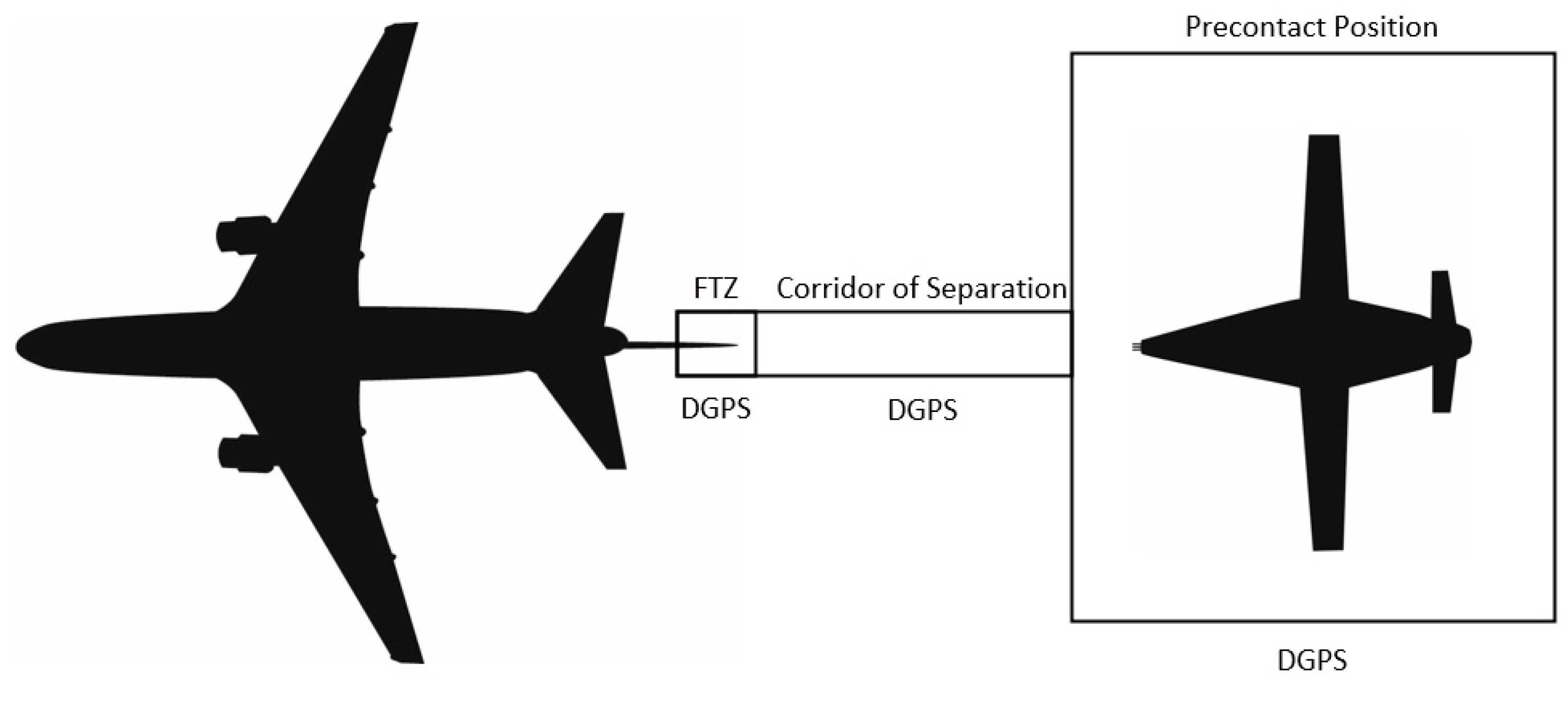
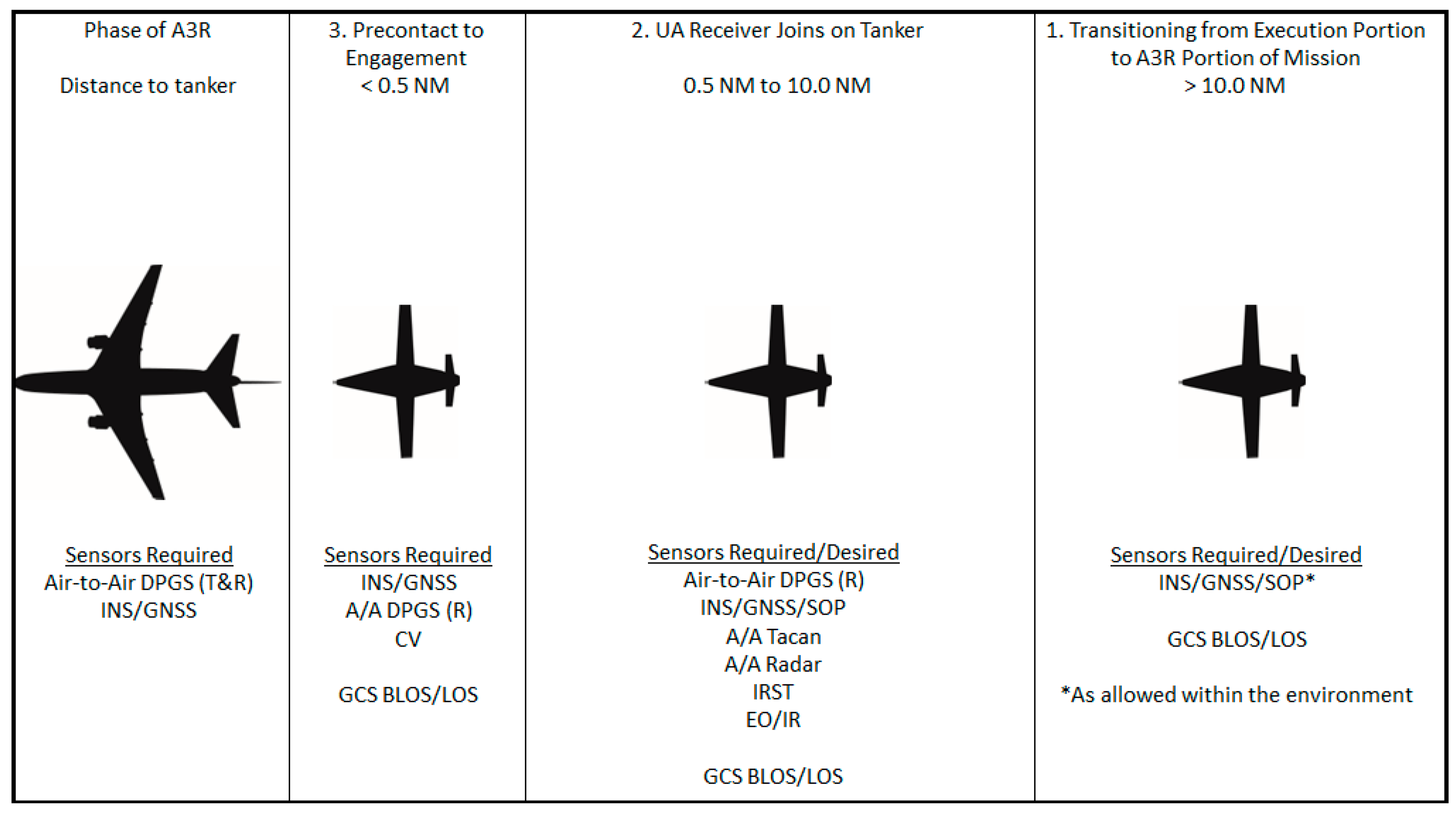
| Sensor * | Purpose | Phase ** | Frequency Band |
|---|---|---|---|
| Data link: GCS to GCS | Transmit data and voice | 1–5 | Fiber, Ethernet, UHF, L, & C |
| Data link: GCS to UA | Transmit data and voice | L & C | |
| Data link: UA to UA | Transmit data | L & Ku | |
| Tanker and Receiver INS | Position and Timing | --- | |
| GNSS Receiver | Update INS | 1–5 | L |
| SOP Receiver | 1, 2 | MF, VHF, UHF, K and L | |
| A/A Tacan | Target (tanker) information | 1–5 | UHF |
| A/A Radar | 1, 2, 4, & 5 ** | X | |
| IRST System | 1–5 | Passive | |
| EO/IR System | 1–5 | Visual & IR | |
| DGPS Tanker (T&R) *** Receiver (R) | Guidance information | 2–5 | L & Ku |
| EO/IR System | CV for guidance | 3 | Visual * IR |
Disclaimer/Publisher’s Note: The statements, opinions and data contained in all publications are solely those of the individual author(s) and contributor(s) and not of MDPI and/or the editor(s). MDPI and/or the editor(s) disclaim responsibility for any injury to people or property resulting from any ideas, methods, instructions or products referred to in the content. |
© 2023 by the authors. Licensee MDPI, Basel, Switzerland. This article is an open access article distributed under the terms and conditions of the Creative Commons Attribution (CC BY) license (https://creativecommons.org/licenses/by/4.0/).
Share and Cite
Parry, J.; Hubbard, S. Review of Sensor Technology to Support Automated Air-to-Air Refueling of a Probe Configured Uncrewed Aircraft. Sensors 2023, 23, 995. https://doi.org/10.3390/s23020995
Parry J, Hubbard S. Review of Sensor Technology to Support Automated Air-to-Air Refueling of a Probe Configured Uncrewed Aircraft. Sensors. 2023; 23(2):995. https://doi.org/10.3390/s23020995
Chicago/Turabian StyleParry, Jonathon, and Sarah Hubbard. 2023. "Review of Sensor Technology to Support Automated Air-to-Air Refueling of a Probe Configured Uncrewed Aircraft" Sensors 23, no. 2: 995. https://doi.org/10.3390/s23020995






